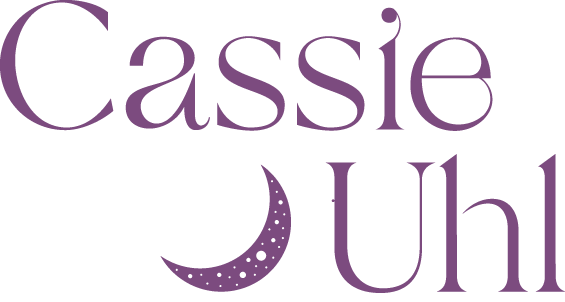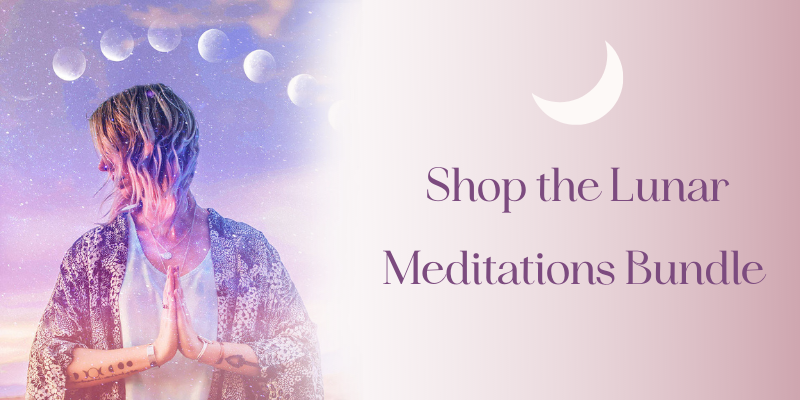How to Open Your Sacral Chakra & Know When it's Blocked
The sacral chakra, Svadhisthana, is one of the chakras I personally feel most connected to. I think in the spiritual community, we can sometimes forget how important the lower chakras are, but remember: you are a spiritual being in a physical body! So the chakras we tend to associate with our physical bodies more, like the root, sacral, and solar plexus chakras, are just as important as the higher chakras like your crown and third eye.The sacral chakra is your center of creativity, sexuality, and feeling. It’s ruled by the element of water, and it’s located at the center of your low belly about three inches from your navel.
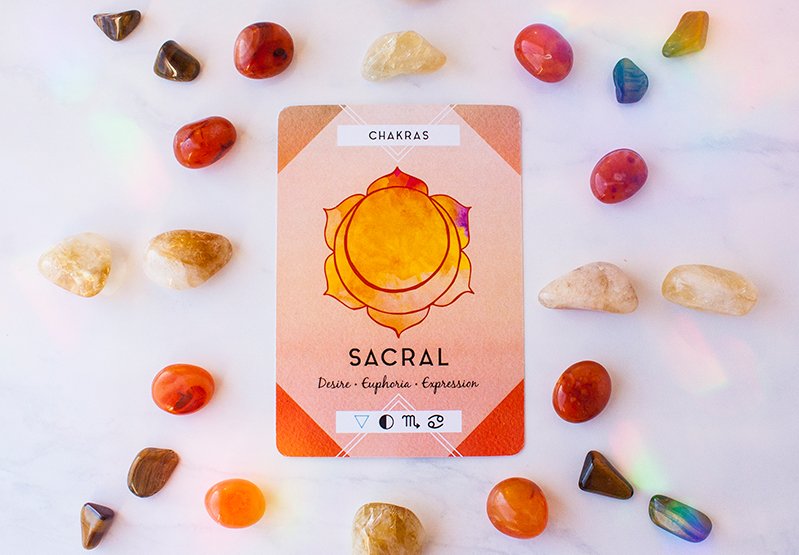
The sacral chakra, Svadhisthana, is one of the chakras I personally feel most connected to. I think in the spiritual community, we can sometimes forget how important the lower chakras are, but remember: you are a spiritual being in a physical body! So the chakras we tend to associate with our physical bodies more, like the root, sacral, and solar plexus chakras, are just as important as the higher chakras like your crown and third eye.
The sacral chakra is your center of creativity, sexuality, and feeling. It’s ruled by the element of water, and it’s located at the center of your low belly about three inches from your navel.
When this chakra is open, you’re able to feel deep pleasure in your life. You’re able to really feel the world around you and you’re connected to your emotions. You’re able to flow, expand, have healthy relationships with others, and use your creativity.
When this chakra is blocked, it may manifest as:
Disconnection from your sexuality or being ruled by your sexuality
Experiencing a lack of pleasure in your day-to-day life
Inability to connect with your creative energy
Feeling stuck in a certain feeling or mood
Dependency on a person or substance that gives you pleasure
Inability to feel your feelings or being too ruled by your emotions
If any of those sound like you, don’t worry. Our chakras are fluid, just like us, and they can change from day to day. Scroll down to get 10 ways to unblock your sacral chakra to connect with your creative and emotional flow.
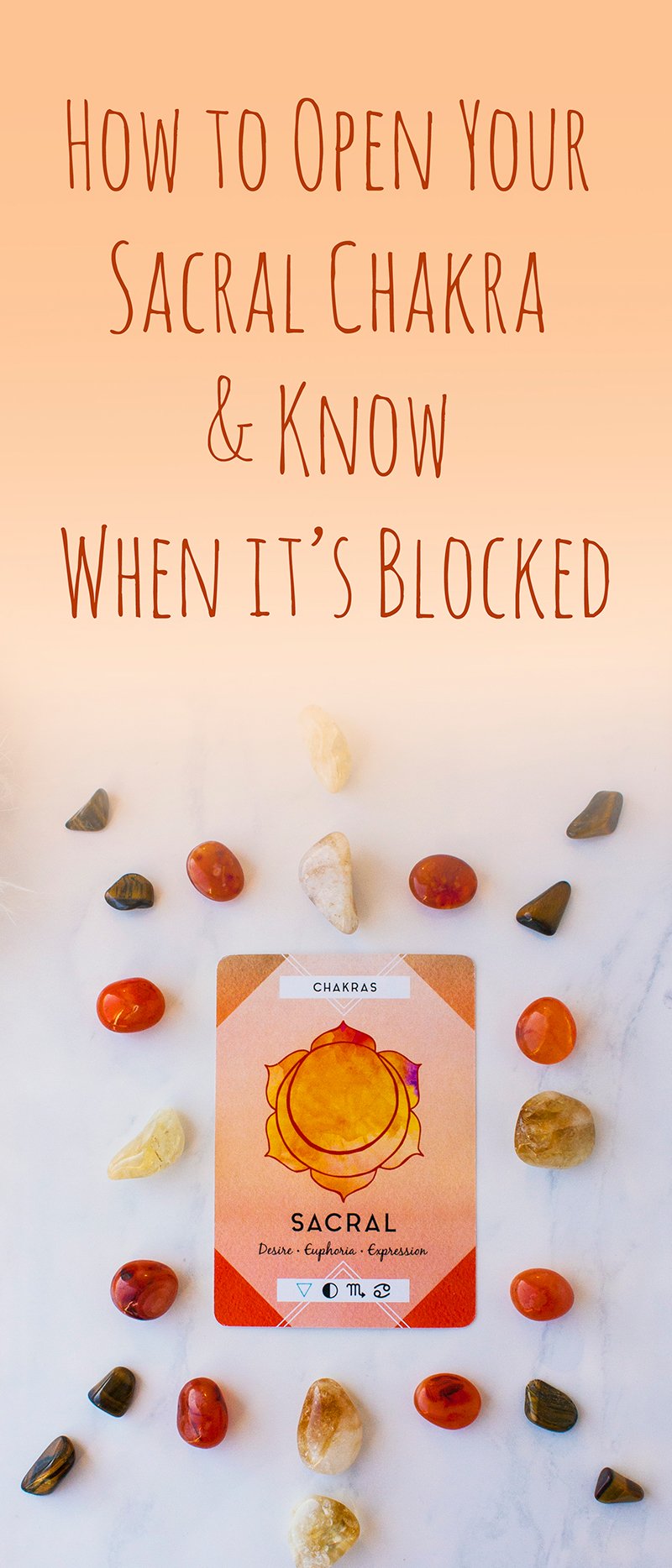
The card shown in the image is from The Ritual Deck.
Get creative
This is one of my favorite ways to open this chakra! Even if you don’t feel creative in the moment, just start creating something. It might surprise you how your energy starts to flow! Try painting, writing, drawing, coloring, collaging, creating your own movement practice, or experimenting in the kitchen.
Use scents
My go-to essential oils for opening your sacral chakra are:
Tangerine
Orange
Ylang ylang
Patchouli
Bergamot
Sandalwood
Rosewood
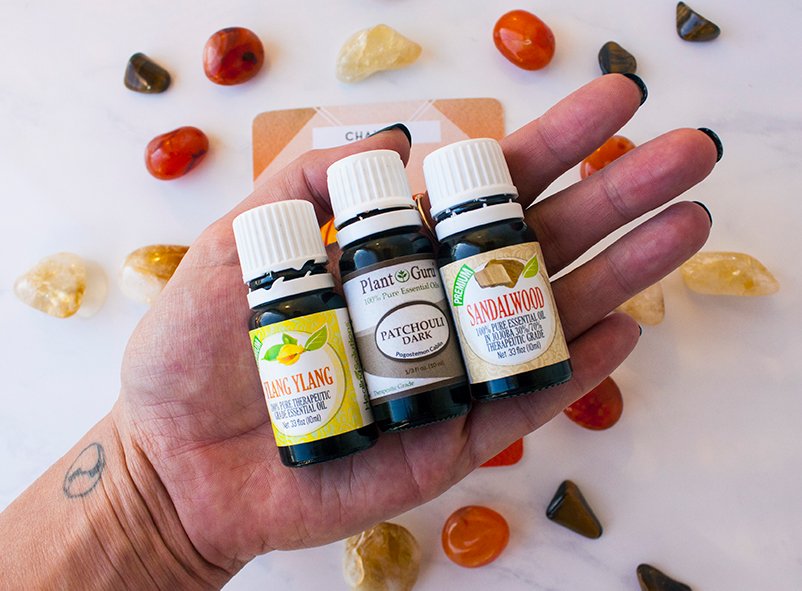
Try massaging your low belly with one or more of the oils (diluting with a carrier oil as needed), diffusing them in your space, or placing a few drops in your bath (which, bonus points, connects you with the element of water!).
Dance
I know everyone says this, but seriously, dance like no one’s watching (because no one is!). Put on your favorite music and move intuitively however feels good for you. If you’d like, incorporate some hip circles to help you get into your low belly.
Breathing into your low belly. As you’re laying down, place your hands on your low belly. With your inhale, feel your hands rise as you flood the belly with breath, sending your life force energy to this chakra. As you exhale, feel your sacral center soften, expand, and open.
Use crystals
Some crystals that help open your sacral chakra are:
Citrine
Carnelian
Orange aventurine
Orange calcite
Goldstone
Tiger’s eye
Sunstone
Peach selenite
Try sleeping with them, meditating with them on your low belly, placing them around your home, or placing a little tumbled stone in your pocket to carry with you all day.
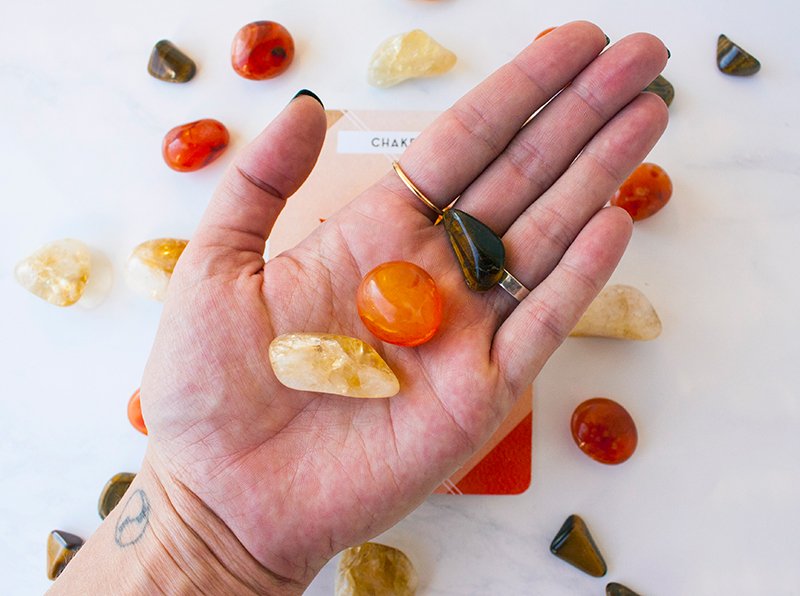
Meditation
Bring your palms to the center of your sacral chakra in your low belly, and start to take deep belly breaths into that space. With each inhale, visualize a little orange ball of light over your sacral chakra. With each exhale, visualize it opening, softening, and expanding until your entire body is surrounded by a beautiful aura of pure orange light.
Check out my Energy Reset Meditation Bundle here.
Use affirmations
Write them down, say them every day, make them the background of your phone—the options are endless! Choose an affirmation from the list below or create your own:
I am fully in my body.
Creative and sexual energy runs through me.
I am in love with life.
I am a passionate being.
I am deeply connected to my feelings.
I honor my feelings.
I honor my pleasure.

Yoga poses
Poses that stretch your hips are really helpful for opening your sacral chakra. Some of my favorites are:
Low lunge
Goddess pose
Reclining cobbler’s pose
Wide-legged standing forward fold
Frog pose
In each pose, just remember to breathe into your low belly!
Get to the root of the blockage
One of my favorite ways to get to the root of a chakra blockage is pulling tarot cards for these two simple questions:
Why is my sacral chakra blocked?
Advice for moving through the blockage
Tarot cards have such a beautiful, helpful way of getting to the heart of the matter. If you’re feeling like there’s a deep, underlying shadow or issue holding you back from fully stepping into your sexual and creative power, try this.
Play with color
The color associated with Svadhisthana is orange. Try bringing more of this color into your life by lighting orange candles, eating orange foods, wearing orange clothes, or painting your nails orange.
Ancient Scents & Their Meanings
Have you ever smelled something and it took you back to a specific moment in your life or a certain feeling?We can’t always explain why scents attach themselves to moments in our lives and stick, but we know that scents are powerful.

Have you ever smelled something and it took you back to a specific moment in your life or a certain feeling?
We can’t always explain why scents attach themselves to moments in our lives and stick, but we know that scents are powerful.
Think about how you feel when you smell fresh cut grass, the incense burning in your local yoga studio, onions sautéing on the stove, or winter candles burning.
Each one of those scents probably evokes a specific emotion in you.
This is the power of scents.
Smell is one of the most primal senses, and it can awaken the deep emotions that may be hiding in your cells.
Scents are a way to connect to our heart space. They’re a way to shift our energy, our emotions, and our mood. They can also be an incredible way to connect with the Universe or the Divine.
Some scents, such as the ones below, have their roots in ancient civilizations around the world. They’ve been used for their magickal healing properties in the ancient civilizations of India, Rome, China, Egypt, and more.
Why?
Scroll down to learn more about some of the most powerful ancient scents' meanings and uses.

Frankincense
Frankincense has been used for centuries in the Middle East (where it’s from), Egypt, Israel, Ancient Rome, Ancient Greece, other parts of Europe, and more.

In different cultures, it was used for different things:
As incense in sacred Jewish rituals, Christian ceremonies, and other religious ceremonies in Greece, Rome, Egypt, and Israel
Healing and purification in the Ayurvedic tradition
To drive insects away in the Middle East
Flavoring food and drinks in the Middle East
In burial rituals in Egypt and Rome
To treat medical issues including ulcers, nausea, post-childbirth recovery, chest coughs, and fever
To embalm bodies in Ancient Egypt
Besides its practical uses, it was revered as a powerful tool for protection, purification, and connecting with the divine.
How can you incorporate frankincense into your life today? Here are some ideas:
Burn frankincense resin as an offering to a goddess you’re working with
Use frankincense oil to anoint your candles in candle magick
Use frankincense oil (diluting with a carrier oil if needed!) on your wrists before meditation or ritual work
Rub the soles of your feet with frankincense oil before bed to help you relax
Diffuse frankincense oil on summer nights on your porch for a natural bug spray
Use frankincense oil as a perfume on your skin to imbue your day to day with some extra magic
Burn frankincense incense in your space to protect and purify it
Myrrh
Myrrh also comes from trees in the Middle East and North Africa, and was used alongside frankincense in the great ancient civilizations of Egypt, Israel, Europe, and the Middle East. Where frankincense is associated with the sun, myrrh is a bit murkier. It’s associated with the sun because its tree thrives in the desert sun, but it’s also associated with the moon, because of its strong feminine history as an herb for ancient goddesses.
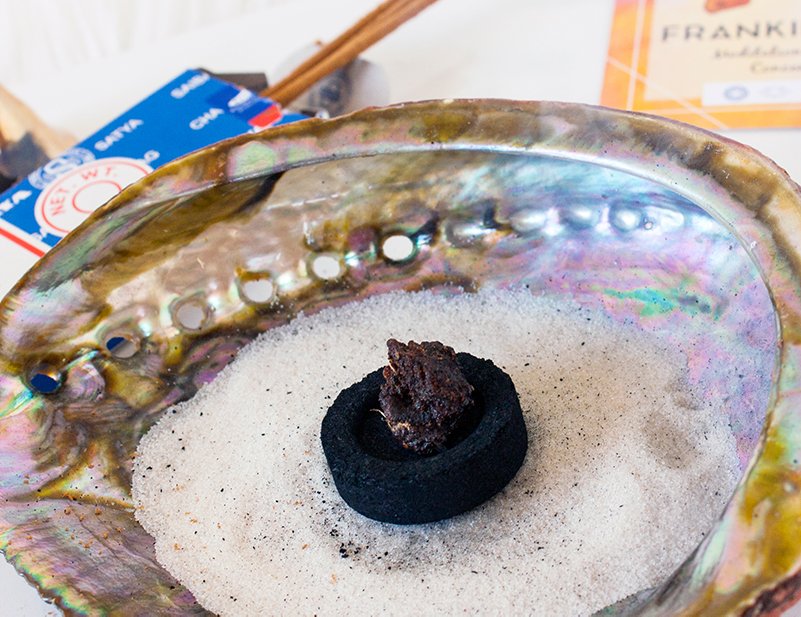
Some of its historical uses are:
Embalming the dead in ancient Egypt
Used as medicine, especially with honey, in ancient Egypt for many illnesses, especially skin conditions, infections, and bruises
Burning as sacred incense in Christian traditions
Used in ancient Egyptian rites as an offering to the sun god Ra and goddess Isis
As a perfume and purification oil for the Hebrew people
For its restorative properties in Eastern medicine
Myrrh was used as a powerful tool for healing, protection, purification, meditation, and expanding inner wisdom. It was often used as a great complement to frankincense, and it’s thought that combining the two even increases their power.Try these ideas for incorporating myrrh into your life today:
Burn myrrh resin on your altar as an offering to the goddess Isis
Use in banishing and protection rituals and spells
Purify and bless magical tools such as your tarot cards, crystals, and talismans
Burn myrrh incense when you need personal healing and comfort
Use myrrh oil on your skin (diluting with carrier oil if necessary) to help you meditate
Incorporate into any of your work with frankincense above
Sandalwood

Sandalwood isn’t technically an herb. It’s actually, like the name suggests, a type of wood. Sandalwood has been used for thousands of years in many different contexts, including:
Buddhist rituals
Muslim rituals
Egyptian embalming rituals
Folk medicine in Tibet and China
In carvings for shrines and homes in India
In figurines and jewelry in India
As a paste for anointing in Hindu temples
As a perfume and soap in Europe
As a powerful remedy in the Ayurvedic system of medicine
Consecrating ritual tools in Hindu ceremonies
Practically, sandalwood has been used for its anti-inflammatory and cleansing properties. Magically and energetically, sandalwood has been used for many things including healing, purification, grounding while also assisting in meditation, clearing negativity, deep spiritual relaxation, clairvoyance, and manifestation.Some ways to use sandalwood in your life are:
Write your desires on a stick of sandalwood on the new moon and burn it, letting the smoke carry your desires into the universe
Cleanse your magical tools (like crystals, athames, cauldrons, and tarot cards) of negative energy
Burn sandalwood chips to help heal coughs and UTIs
Burn sandalwood incense for meditation
Burn sandalwood incense or chips for astral projection and communicating with spirits
Wear sandalwood beads for higher spiritual awareness
Nag Champa
If you’ve ever walked into a yoga studio or a witchy shop, you’ve probably smelled the earthy, slightly sweet scent of Nag Champa. But what is Nag Champa?
It’s a blend of different scents, most famously the champa flower, as well as sandalwood, and halmaddi resin. The champa flower from the Magnolia champaca tree, a tree often planted near ashrams, has long been prized in India for its sweet fragrance and bright yellow color.
As you’ve probably guessed, Nag Champa’s origins are as incense in India where it was often used for meditation, yoga, and rituals in Hindu temples and ashrams. It’s now one of the most popular incense scents in the world!
Nag Champa is thought to stimulate spiritual awareness while simultaneously grounding you in the present.

Here are some ideas for incorporating this popular scent into your life:
Burn Nag Champa when you meditate or do yoga
Use Nag Champa oil as a perfume
Burn Nag Champa for chanting and kirtan practices
Use Nag Champa oil to massage your feet (diluting if needed!)
Use Nag Champ soap or body wash (there are tons of options) to add some magic to your everyday
How to Balance Your Throat Chakra & Know When It's Blocked
When your throat chakra, Visuddha, is balanced, you’re able to speak your authentic truth from a place of love. You set loving and firm boundaries, and stick by them. You’re able to find your voice and share your unique gifts with the world. You trust that what needs to come through you will come, and you don’t get stuck in self-judgment or self-doubt wondering if you should or shouldn’t say something.
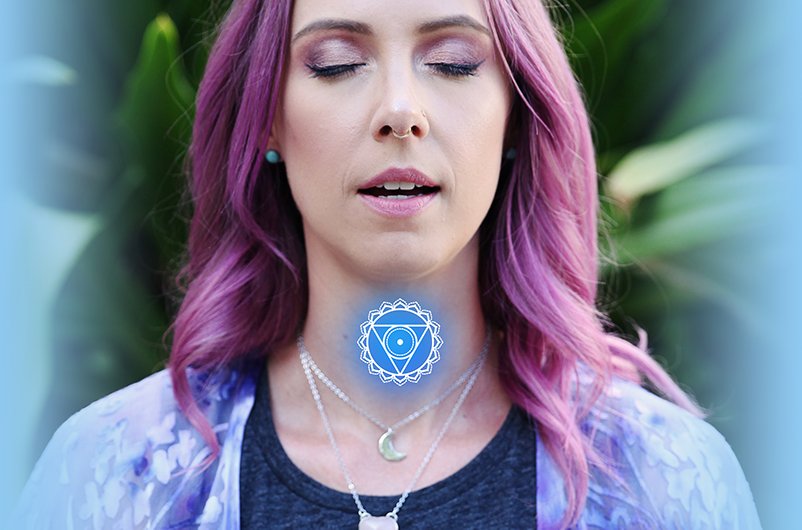
When your throat chakra, Visuddha, is balanced, you’re able to speak your authentic truth from a place of love. You set loving and firm boundaries, and stick by them. You’re able to find your voice and share your unique gifts with the world. You trust that what needs to come through you will come, and you don’t get stuck in self-judgment or self-doubt wondering if you should or shouldn’t say something.
So many of us get blocked at our throat chakra. When your throat chakra is blocked, it may show up as:
Holding back from saying what you’re thinking and feeling
Not standing up for yourself
Not having strong boundaries
Being afraid to be seen for who you are
Having a sore throat, neck pain, or hoarseness in your throat
Fear of being judged for what you say
Having trouble listening to others
Always needing to have the last word
Scroll down to look through some simple tips for opening your throat chakra.
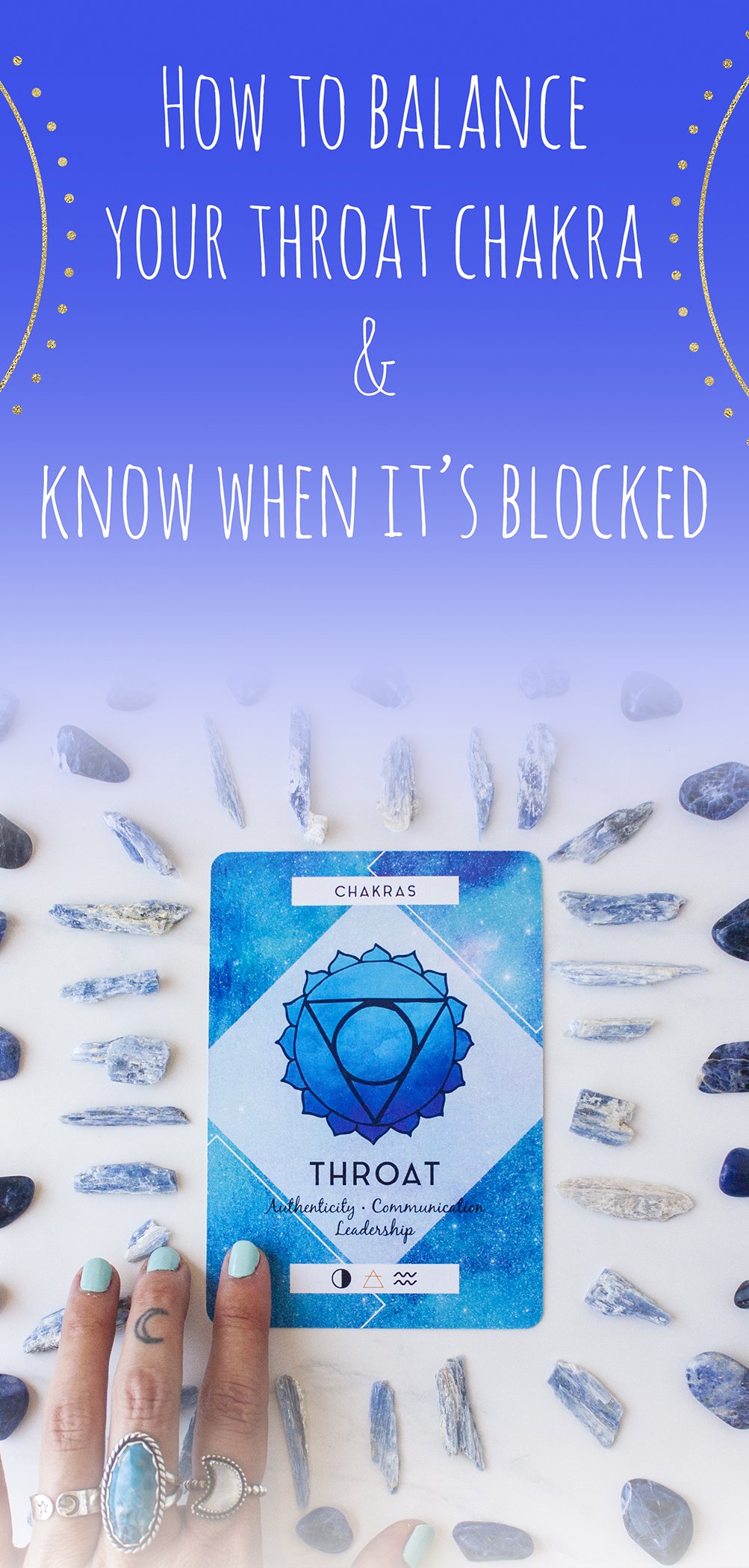
Featured card from The Ritual Deck
Yoga Poses
Any yoga pose that stretches your throat is going to be really opening for Visuddha. Try one of my favorites below!

Upward-facing dog
Lift your chin and breathe deeply into your throat space. Try holding this pose for a few breaths instead of just flowing through it on your way from plank to downward facing dog.
Heart-to-Earth pose
Try heart-to-earth pose coming onto your chin instead of your forehead. This is a really deep stretch, so have blocks or blankets nearby to help you if you need them!
Camel pose
If your neck is healthy, try releasing your head instead of keeping your chin tucked. Bring your awareness to your breath flowing through your throat, dissolving any blockages.
Crystals
Working with crystals can be a beautiful tonic for your throat chakra. Try laying on your back and placing one of these crystals on your throat, sleeping with them by your pillow, or simply meditating holding one of them in your non-dominant hand.
Sodalite to help you express yourself, set boundaries, and grow your self-worth and self-esteem
Celestite to promote peace and soothe anxiety
Lapis lazuli to help you communicate effectively
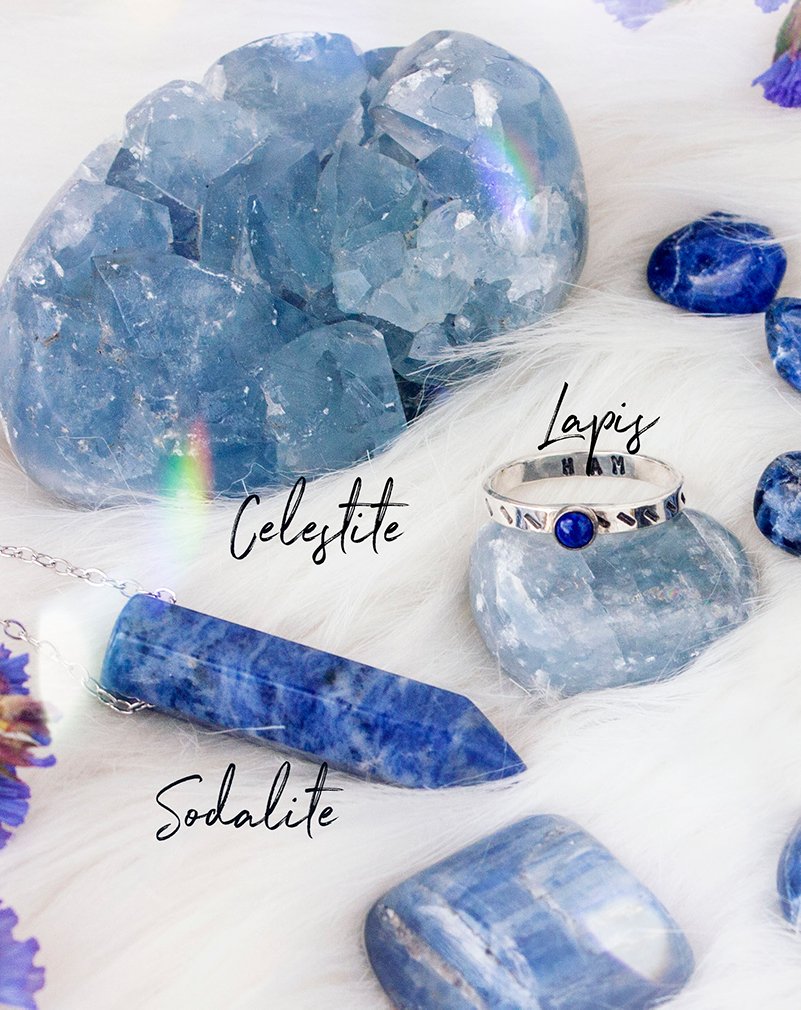
Scents
Plants are here for us as medicine, so let’s use them. Pick your favorite essential oil (or two, or three!) from the list below and diffuse it, make a rollerball to use on your skin, or put drops in your bath.
Jasmine for greater communication
Clary sage to allow energy to flow more freely through your body
Cypress for transformation and renewal
Eucalyptus to promote inner freedom and expansiveness

Work with Tarot Archetypes
Queen of Swords and King of Swords can be your inspiration for opening your throat chakra. The Queen of Swords helps you do the inner work you need to understand why your throat chakra is blocked, and the King of Swords reminds you that you do have something unique to share and that what you have to offer can only come through you.Try this Queen of Swords inspired tarot spread to help you understand why you might be energetically blocked in this area:
What am I afraid will happen if I speak my truth?
The wound or shadow underneath this blockage
Advice for healing this blockage
Why am I afraid to set boundaries?
The wound or shadow underneath this blockage
Advice for healing this blockage
Mantra for working with the throat chakra
Journal about anything that comes up for you as you pull these cards. Place the Queen of Swords and King of Swords on your altar to remind you to speak your truth.
Meditate
I find that the heart chakra and throat chakra are so connected. If your heart space is closed, you’ll feel disconnected from your truth and not even sure what boundaries need to be set, so how can you speak your truth and set boundaries?
Try coming to a comfortable seat, closing your eyes, and placing one hand on your heart and one hand on your throat. Send your breath to your heart space, simply visualizing it arriving there and filling your entire heart with prana, life force energy.
When your heart feels full, begin to send your breath to your throat. Visualize your breath flooding this area, dissolving any blockages with love. Continue breathing into your throat space for as long as you feel you need.
Affirmations & Mantras
The bija mantra for the throat chakra is ham (pronounced “hum”). Try chanting that mantra, silently or out loud (out loud is super powerful!), or work with one of the affirmations below:

I speak my truth with love
I set firm boundaries easily
I clearly state my needs
My truth is love
I speak my feelings easily
I claim and honor my truth
I release judgment over what I did or didn’t say
Play with Color
The color associated with the throat chakra is blue. Try incorporating this color into your life more! Some ideas to spark your creativity:
Paint with different shades of blue
Eat blue foods such as blueberries, blackberries, and plums
Write in a blue journal with a blue pen
Light blue candles
Wear blue clothing
How to Open Your Crown Chakra & Know When it’s Blocked
Your crown chakra, known as Sahasrara in Sanskrit, is the highest of the seven chakras in the traditional chakra system. It’s located on the crown of your head and is the center of your connection with the Universe and with your highest self.It’s where you’re able to channel messages from the divine, access higher states of consciousness, and deeply trust the Universe. An open crown chakra helps you connect with something greater than yourself, experience the interconnectedness of all beings, and know that you are truly taken care of by an abundant, loving Universe.
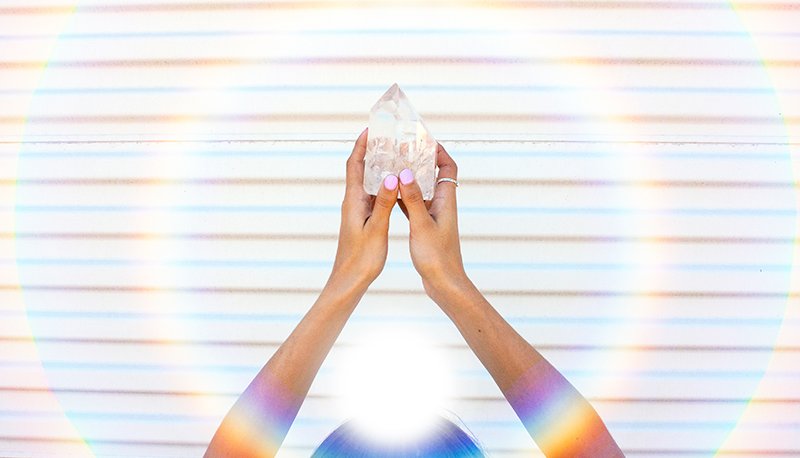
Your crown chakra, known as Sahasrara in Sanskrit, is the highest of the seven chakras in the traditional chakra system. It’s located on the crown of your head and is the center of your connection with the Universe and with your highest self.It’s where you’re able to channel messages from the divine, access higher states of consciousness, and deeply trust the Universe. An open crown chakra helps you connect with something greater than yourself, experience the interconnectedness of all beings, and know that you are truly taken care of by an abundant, loving Universe.When your crown chakra is blocked, it may manifest as:
Feeling disconnected from the Universe
Feeling disconnected from magic
Experiencing loneliness
Feeling like life is meaningless
Disconnection from your spiritual side
Experiencing migraines and headaches
Strong attachment to material possessions and achievements
If any of those sounds like you, don’t worry. Our chakras are ever fluid, just like us, and they can change from day to day. Scroll down to get eight ways to unblock your crown chakra and experience a connection with the divine.
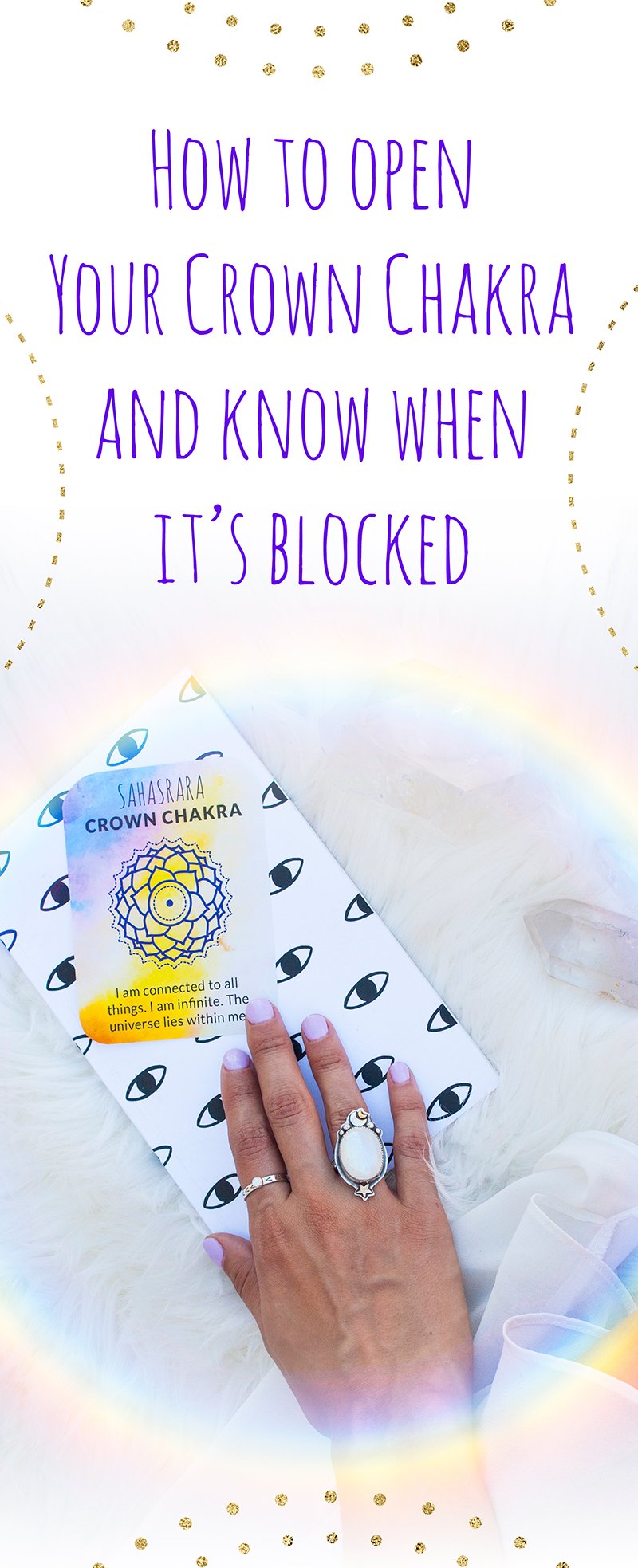
Slow down
Are you stuck in the “grind?” Waking up, going to work, taking care of all the necessary human things in life but not tending to your inner world?The first thing you can do to open your crown chakra is to simply give it space to breathe by carving out more time in your day to just be. To read a good book, take a salt bath, or take a leisurely walk with the purpose of just experiencing the pleasure of the outdoors rather than getting somewhere.
Do a ritual
Maybe it’s been a while since you sat at your sacred space and made time for magick. That’s okay! Open your crown chakra by doing a ritual that is meaningful to you, or try this simple one.You’ll need:
Purple candle
Pen
Piece of paper
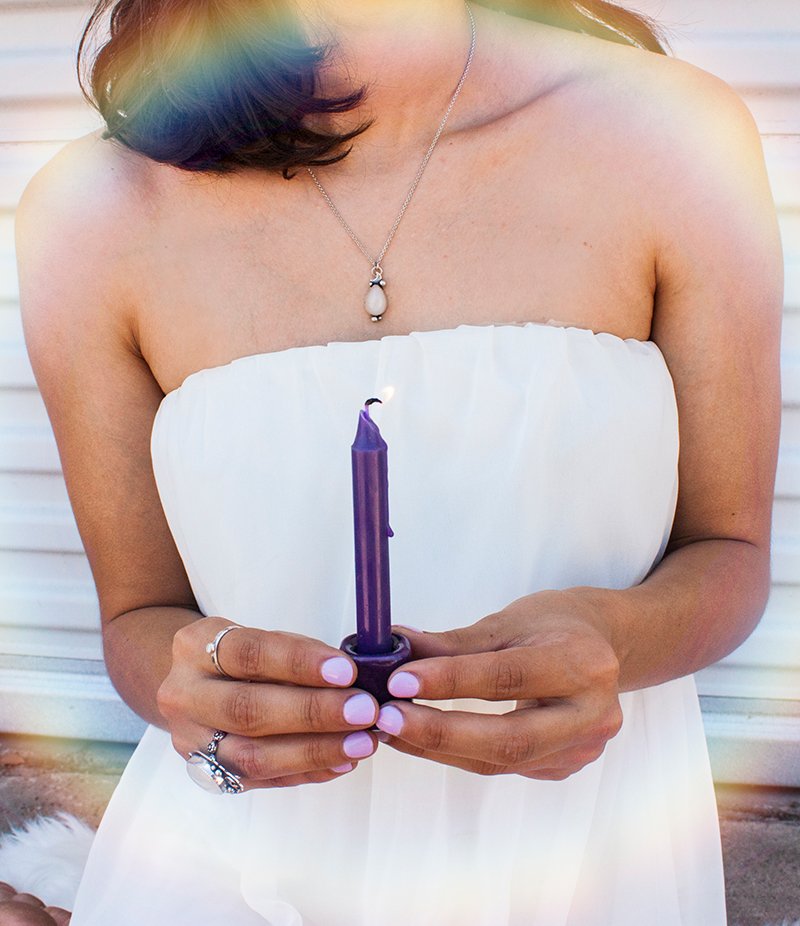
On your paper, write “I connect with the Universe” or a similar phrase. Create a sigil out of the phrase by removing all of the repeating letters and vowels, and connecting the lines together into a symbol.
Breathe that intention into your sigil. Take a moment to visualize how you will feel when your crown chakra is open and energy is flowing freely.
Then, light your candle, and burn your sigil over it as you continue to focus on your intention. You might like to say, “As I burn this paper, I connect with the Universe.”
You can rewrite your sigil on another page and place it on your altar as an ongoing prayer to the Universe.
Affirmations
The crown chakra is not associated with a bija (seed) mantra like the rest of your chakras. Try meditating on one of the affirmations below instead.
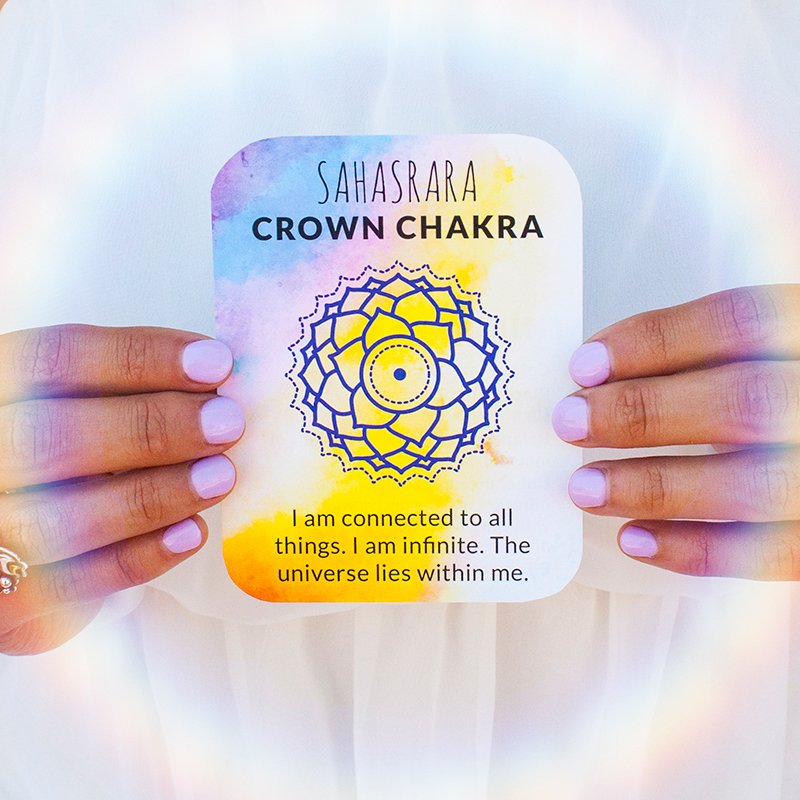
I am deeply connected with the Universe
I trust the flow of the Universe
I am a channel for divine wisdom
I am a channel for divine light
I am always open to receiving messages from the Universe
I am magic
I am light
I am a deeply spiritual being
Use scents
Try using one or more of the oils below on your skin, in your bath, or in a diffuser to open Sahasrara:
Frankincense for tranquility and meditation
Vetiver to connect with the divine and your own spiritual nature
Sandalwood to quiet your mind and ego
Helichrysum to help you access higher spiritual states
Palo Santo for healing, purification, and opening up to higher spiritual realms (be sure it comes from a sustainable and ethical source)
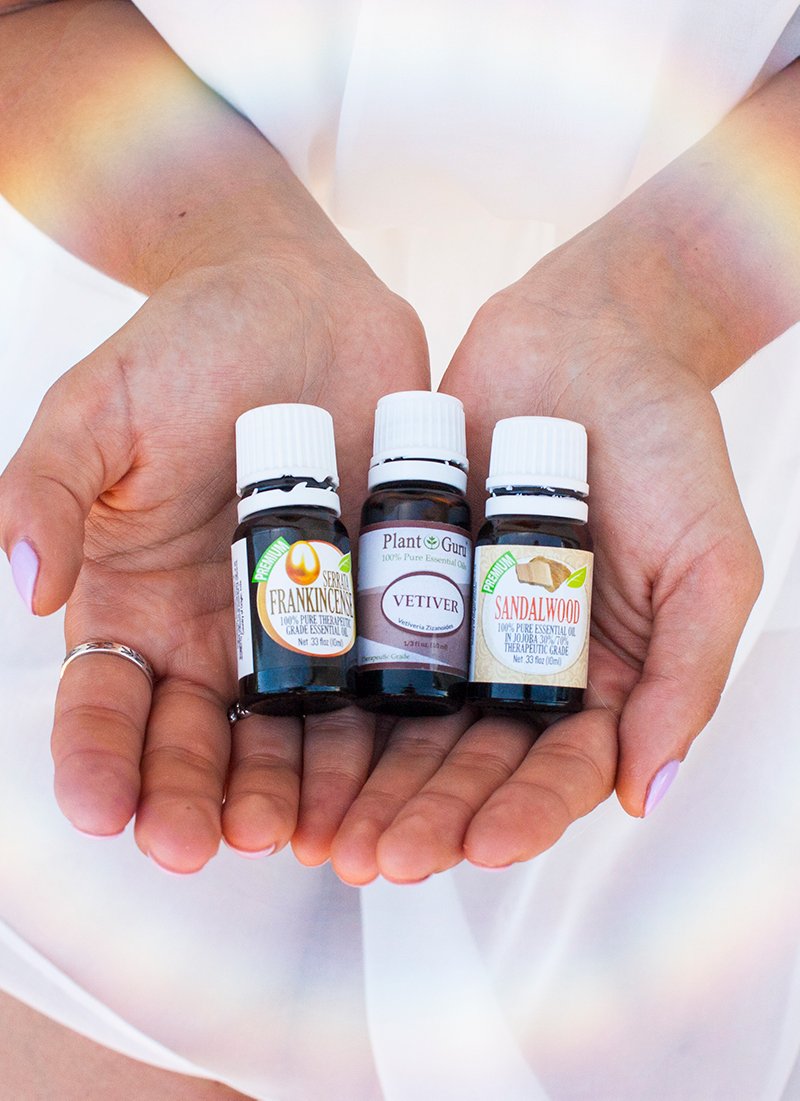
Learn more about balancing your chakras with aromatherapy and crystals from this past blog post.
Meditate
Find a comfortable seat and lengthen your spine from your tailbone to your crown. Start to breathe deeply, focusing on sending your breath to a white flower at the crown of your head.
As you continue to breathe, visualize this flower blossoming open, opening the crown of your head as a channel to the Universe, letting the bright white light of the divine enter your energy field.
When you feel complete, close with a deep breath in and a long breath out of your mouth.
You can also try one of our guided meditations here.
Crystals
Try working with rutilated quartz, clear quartz, sugilite, selenite, or amethyst to help you open your crown chakra. Meditate with them, place them on your altar or by your pillow while you sleep, and journal with them to see what comes up around what’s blocking your crown chakra.
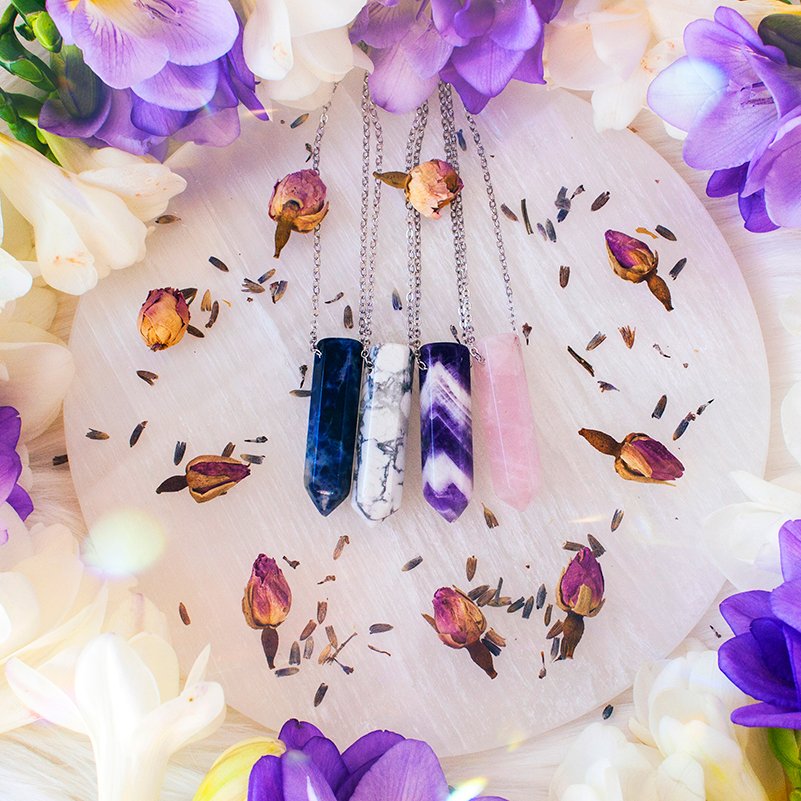
Yoga poses
As we move up the spine to the higher chakras, they become more affected by meditation than by physical postures. But there are still some yoga poses you can use to open Sahasrara:
Headstand
This pose directly activates your crown chakra. It restores the flow of energy in your body and inverts the flow of blood towards your crown. If you have trouble balancing in headstand, try doing this pose against the wall— you’ll still get the benefits!
Savasana
The most important yoga pose. As you come into savasana, set your intention to open your crown chakra. Then remind yourself that it is safe to relax completely, and release into your savasana.
Half or full lotus pose
Lotus pose helps balance the body and mind, helping you tap into higher consciousness. Find a comfortable seat, and start in half lotus. If you’d like to go deeper, try the full version.
Pray
Send a simple prayer into the Universe: “Please help me connect with you. I am open and willing to receive messages.” Try saying this prayer or a similar prayer that resonates with you each morning when you wake up.
Yoga for the Dark Moon
I love the dark moon.The dark moon is all about resting (think four of swords in the tarot), taking care of yourself, and shedding anything that still needs to be released this cycle.The name of the game at the dark moon is soft, slow, and gentle. There’s no need to push yourself. What would make you feel good at this time? What would nurture your body, mind, and soul?A yin yoga practice is so lovely at this time of the month. The practice below focuses on gentle opening and a little twisting to help you sink into your body and breath. You’ll want to hold each of the poses for 3-5 minutes and let yourself really relax into them.

I love the dark moon.
The dark moon is all about resting (think four of swords in the tarot), taking care of yourself, and shedding anything that still needs to be released this cycle.
The name of the game at the dark moon is soft, slow, and gentle. There’s no need to push yourself. What would make you feel good at this time? What would nurture your body, mind, and soul?
A yin yoga practice is so lovely at this time of the month. The practice below focuses on gentle opening and a little twisting to help you sink into your body and breath. You’ll want to hold each of the poses for 3-5 minutes and let yourself really relax into them.

Grab your own moon phase ritual cards including the dark moon card featured above by clicking here.
I invite you to use a mantra or affirmation that speaks to you during this practice: a simple and beautiful one is Soham, or “I am.” This affirmation brings you right into the present moment and allows you to be still with what is.

Get into something comfy, and grab your blocks, a blanket, a pillow, essential oils, and whatever else would make this practice really nourishing for you. Turn on your favorite yoga playlist, light some candles, and roll out your mat.
Cobbler’s pose
Sit up on a block or blanket, and bring the soles of your feet together. Bring your hands to your feet, and give yourself a little foot massage. Rub your feet, your ankles, your calves, and if you feel like getting wild you can make your way up to your neck and shoulders, too! If you’re using essential oils, you can incorporate them here. A simple warming sesame oil would also work.
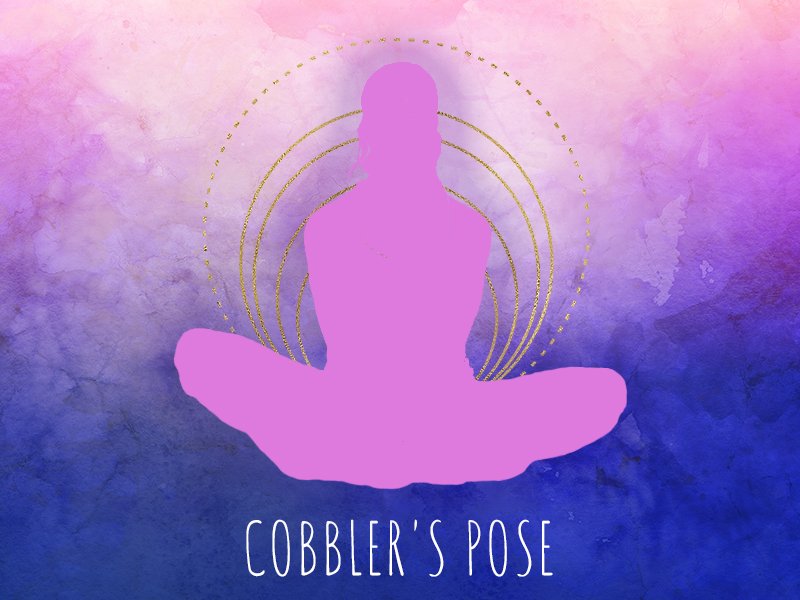
Shoulder opener
Laying on your belly, stretch your left arm out to your side and roll onto your left cheek. Bring your right palm under your right shoulder and roll onto your left hip. You can stay here, or you might like to go a little deeper by bending your right leg and planting your right foot behind you, and wrapping your right arm around your back.
Stay here with your breath for 3-5 minutes. Then come back to center and repeat on your right side.
Half frog
On your belly, stretch your arms out to a T and roll onto your left cheek. Open your right knee out to your side, stretching it out even with your hip if you can. If your knee is sensitive, slide your blanket under it. Allow yourself to be supported in this pose, and remind yourself that it is safe to relax completely.
After 3-5 minutes, shift back to center and over to the other side.

Cat cow
As you breathe through each movement of flexing and rounding your spine, visualize your breath flowing up and down your spine all the way from your tailbone to the crown of your head. Make this dynamic pose your own by taking circles or figure eights with your hips, stretching through your side body, coming onto your fingertips to get deeper into your back, or coming back for a child’s pose. What is your body craving here? Let your breath take you there.

Child’s pose
Try bringing your big toes together and knees wide, and roll a blanket or place a pillow between your legs. Release your chest and forehead onto your makeshift bolster. If you need to, feel free to turn your head to one side. Just make sure you turn it to the other side after a few minutes!
Heart Bench
Set up your blocks at two different heights at the top of your mat: the low and medium setting, or the medium and high setting. The second block should be vertical (long like your mat) and the first block at the very top of your mat should be horizontal.
Lower your back onto your blocks, first setting the second block up to run along your spine and end under your shoulder blades. The first block will come to the base of your skull, supporting your head and neck.
Bring the soles of your feet together and knees wide, and both palms to your belly. Breathe deeply into your belly, noticing how it feels to really expand in this area where we so often try to shrink and contract.
Let your awareness melt away after a few moments, and completely relax into this pose.
Supine Twist
Hug your knees to your chest and guide both knees over to one side, stretching out your opposite arm and turning your head in that direction. If there is a gap between your knees, it could feel good to slide a block between them. After 3-5 minutes, switch to the other side.
In this twist, bring your awareness to anything you’d still like to shed or release this cycle. With each exhale, visualize it leaving your body, mind, and soul.
Savasana
Even if you’re tempted, don’t skip savasana! This is the most important part of any yoga practice, especially with the dark moon. Get cozy here with any combination of pillows and blankets that feels good to you. You might like to put a pillow under your head, a rolled blanket under your knees, or even take a grounding crone savasana on your belly with each shoulder resting on a block. Stay here for 5 minutes or longer, allowing yourself to really rest. If you have plenty of time, find a yoga Nidra meditation to play.

After you finish your practice, you might like to take out your journal and write about anything that came up for you here.
Breaking Down the Yamas & Niyamas
In classical yoga philosophy, we use something called the Patanjali’s eight-fold path for guidance. These eight limbs, or steps, help us reach the state of ecstasy and deep connection with the divine known as samadhi.

If you’re reading this, you probably already know that there is a lot more to yoga than just asana, or physical postures.

In classical yoga philosophy, we use something called the Patanjali’s eight-fold path for guidance. These eight limbs, or steps, help us reach the state of ecstasy and deep connection with the divine known as samadhi.
Patanjali’s eight-fold path for guidance are:
Yamas
Niyamas
Asana
Pratyahara
Dharana
Dhyana
Samadhi
In this blog, I’ll be breaking down the first two limbs: the yamas and the niyamas.

Yamas
The first limb, the yamas, are about personal practices that relate to our interactions with others and to the outer world. They are:

Ahimsa, nonviolence
Satya, truthfulness
Asteya, non-stealing
Brahmacharya, moderation
Aparigraha, non-attachment
Ahimsa
This is probably the most well-known of the yamas (you probably know a yoga studio, clothing line, or juice bar named after this one, even if you didn’t know what it meant until now), with good reason.
Ahimsa isn’t just about a lack of violence, it’s about active compassion. To connect with this principle, ask yourself how you can bring more compassion into your relationship with yourself and each interaction with others.
Satya
Satya, truthfulness, speaks to not just honesty but to speaking your personal truth. To me, this principle is super connected to the throat chakra.
What does it feel like when your throat chakra is balanced? When you aren’t afraid to speak your truth, even when it’s uncomfortable? This is satya.
Asteya
Asteya, non-stealing, is about not taking what isn’t ours. This practice isn’t just about stealing physical items. Most of us wouldn’t steal a bracelet or a snack from a store. But what about stealing someone’s ideas? What about when you get extra change at the store or when a teacher you love accidentally registers you for an online course you never paid for? What then?
Coming back to this principle of non-stealing is a guiding light.
Brahmacharya
Brahmacharya is all about moderation, or as I like to think of it, balance. It’s an invitation to develop a self-care practice and most importantly, to remember to feed all parts of yourself.
It’s a reminder to come back to your center. To make space in your life for dancing and meditating, for green juice and French fries, for deep conscious connection and memes—or whatever else looks like balance for you.
Aparigraha
It’s really hard to practice aparigraha. The idea of non-attachment is that it’s none of your business how your work is received. Whatever it is that you put into the world, do it for the joy of creating, for the joy of connecting, for the joy of doing the thing, not for some end result.
We can do this in all areas of our lives: our interactions with our friends, families, and partners, our careers, our passion projects, everything.
Can you experience pleasure and be present in each moment, rather than being attached to what may happen in the future?
Aparigraha also refers to not being possessive or hoarding. It’s an invitation to allow yourself, your possessions, and your relationships to be in a constant state of flow.
Niyamas
The second limb, the niyamas, are about personal practices that relate to our inner world. They are:

Saucha, purity
Santosha, contentment
Tapas, self-discipline
Svadhyaya, self-study and inner exploration
Ishvara Pranidhana, surrender to God/Goddess
Saucha
Saucha can refer to the purity of the body, but more importantly, it’s about the purity of mind. This is an invitation to explore your thought patterns and limiting beliefs: What’s holding you back here? What thoughts take up the real estate of your mind, and are they serving you? Do judgment, fear, and lack consume your thoughts?
Saucha asks you to look at what’s really going on in your mind, and heal your thoughts.
Santosha
Santosha is about you—what you have and how you feel about it. It’s an invitation to be happy and content with everything that you have (which is a huge feat in a world that is always encouraging you to be unsatisfied and strive for more).
Think of santosha as embodying more lunar, yin energy: the energy of presence, of being, of contentment.
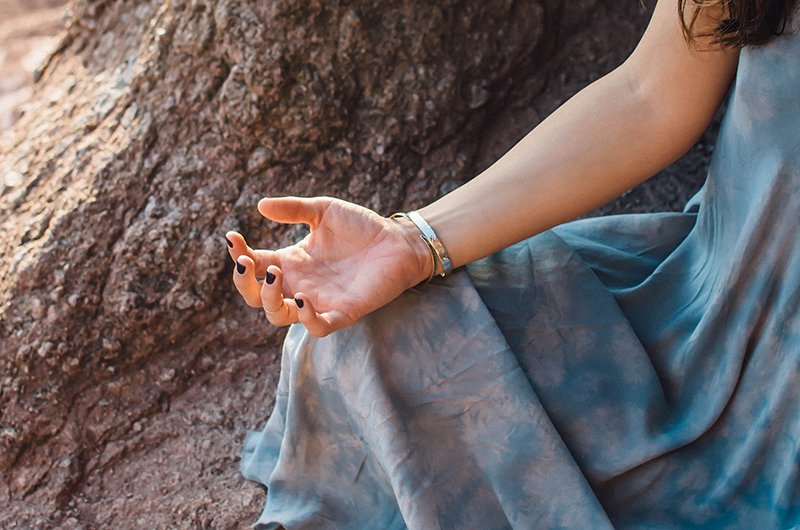
Tapas
Tapas is self-discipline. What is it that you want in life and are you willing to do what it takes to get there? It’s about showing up for yourself and really doing the work: sending those emails, grinding out that report, finishing your work instead of going to that happy hour.
It’s also about doing the work on yourself, by staying on your healing journey and doing the more physical work like eating healthy, practicing yoga every day, and meditating every day.
When you think of tapas, think of the Chariot in the tarot. This is about pushing forward in service of your greater vision.
Svadhyaya
Svadhyaya is key to your spiritual practice.
Who are you, really? What do you value? What are your deepest desires? What are your greatest fears? What brings you joy and purpose?
This niyama is all about learning about yourself and exploring your inner ocean.
Practices like meditating, journaling, shadow work, astrology, past life regression, and divination can all be part of svadhyaya.
Ishvara Pranidhana
Surrender to the energy of a higher power, whatever that means to you: whether it’s Source, Goddess, the Universe, God, or something else.
Practicing all of the other niyamas will help you get into a state where you are able to surrender to the Universe. Where you trust the constant flow of the Universe and know that it is an abundant and loving place where more magic than you could ever imagine is unfolding all the time.
Purify your mind. Practice gratitude. Do what you can with tapas. Explore your inner oceans. And then, it’s time to lay it all at the feet of the Universe and let magic take over.
